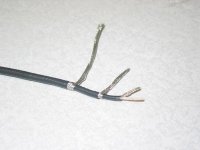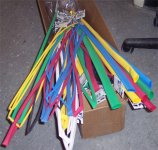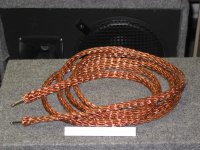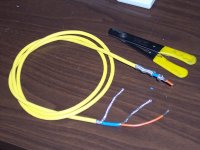Nordic said:On connecting a bipolar PSU... Do you twist together +V, -V and 0V, just +V and -V, or make two 0V leads to make +V and 0V, and -V and 0V leads?
Currenlty I use method A, but not based on any information other than readig about peolpe twisting cable, (heck I even googled and learned how to make braids with cables, never learned how in the more than 10 years I had long hair).
Use neither. Do something I have never seen used in power supply design.
Triaxial.
Take an insulated wire, whatever guage..
Cover it with the braid removed from a microphone balanced run cable..(first ya gotta remove it from the cable..)
ps..I purchased 1000 feet of balanced mike cable for this purpose..
Cover that braid with heatshrink tubing.
Cover that tubing with a second braid.
Cover that with a second heatshrink.
What you have duplicate is a triaxial cable.
Regardless of what current flows where, there will be net zero current flowing through this cable, hence ZERO external emf, at any frequency. This cable also will be impervious to induced voltages along it's length. This frees up the chassis layout design.
ALL connections to the power supply must be through this cable, do not form any chassis loops.
edit: it is of no concern which wire is assigned to which, but I would recommend ground as the outer shield to prevent electric field induced noise from a rail broadcasting into into hi-z circuitry.
Edit: as an added little bonus, the inductance of this cable is gonna be in the mud, you will not be able to measure it. It will run in the 20 to 30 nanohenries per foot range..
Cheers, John
I had considered working with an amp designer or two to put this design into public domain...but the cat is now outta the bag. Perhaps a new thread on this?
The pic is a quadaxial cable..
Attachments
In the case of a bipolar PSU... you twist all three wires. You need to study the current loops... keeps all currents flowing one way right next to the same current flowing the other way... and reduce or cancel the loop areas by twisting.
I once worked on an inverter installation (500 kW) where the electricians did not follow the mechanical layout for the wiring in plastic conduits under the a poured concrete floor... they thought it was silly and wasted wire. They didn't keep the currents together.
After running the invertor for about an hour one day while testing; the concrete under the unit exploded. A chunk of rebar in the concrete had gotten very hot from magnetic induction/eddy currents. While we don't deal with such high power in audio... the principles are the same.

I once worked on an inverter installation (500 kW) where the electricians did not follow the mechanical layout for the wiring in plastic conduits under the a poured concrete floor... they thought it was silly and wasted wire. They didn't keep the currents together.
After running the invertor for about an hour one day while testing; the concrete under the unit exploded. A chunk of rebar in the concrete had gotten very hot from magnetic induction/eddy currents. While we don't deal with such high power in audio... the principles are the same.
Hey, whatttsaa matta??? Ain't dis a DIY site?? C'mon..EC8010 said:And for those of you who don't fancy making the cable up, you can buy ready-made tri-ax from vendors who deal with broadcasters; tri-ax is the standard camera cable.
That'll work well as long as the pitch of the three is tight enough to integrate the helical fields out to zero. I would worry about running the twisted tri near any low level signal paths or grounds. I prefer not considering the texture of the associated electronics.poobah said:In the case of a bipolar PSU... you twist all three wires. You need to study the current loops... keeps all currents flowing one way right next to the same current flowing the other way... and reduce or cancel the loop areas by twisting.
Your solution also guarantees the inductance is in the 200 nH per foot region.
My solution avoids all that.
Don't you love anarchy when it comes to building high power stuff?poobah said:I once worked on an inverter installation (500 kW) where the electricians did not follow the mechanical layout for the wiring in plastic conduits under the a poured concrete floor... they thought it was silly and wasted wire. They didn't keep the currents together.
After running the invertor for about an hour one day while testing; the concrete under the unit exploded. A chunk of rebar in the concrete had gotten very hot from magnetic induction/eddy currents.
poobah said:While we don't deal with such high power in audio... the principles are the same.

High power? Speak for yourself..

(It don't mean a thing, if it ain't got that "sting".
Cheers, John
Edit: spellfix..Condisering...sheesh..sounds like eviscerating.
It ispoobah said:John,
Heat shrink is spendy
poobah said:my 350 kW diesel gas turbine powered bass guitar amp

Sigh..I talk pie in the sky, you talk limitations...
Cheers, John
poobah said:If you would BUY some of that heat shrink; instead of taking samples home so you can "work at night" you would know how 'spensive it is... jeeze.
At work we use tefzel heatshrink, from raychem. That stuff is way too expensive, 2 to 4 dollars per foot. And, we have to buy minimums of about 200 or 250 foot spools. Plus, it's a pain to shrink as it requires way too high a temperature, it will start to melt the insulation of a regular pvc wire.
Nah, I was thinking of PE stuff, the 3M GP 2 to 1 tubing that is sold in 4 foot lengths priced from 1.25 at 1/16th, up to 2.76 for 4 feet of 1/12 inch.
So making a foot long triax would require about two feet of heatshrink, perhaps a buck thirty??
Cheers, John
OH MAN!!!!!poobah said:ok... ok... ok,
We still need to check with SY to see which ceramic colorants are acceptable though...
I forgot all about that..
Nevermind..
Ok, so..now that I have the heatshrink, where's Sy??? I need to know which colors are ok.poobah said:We still need to check with SY to see which ceramic colorants are acceptable though...
The stinkin MSDS says exactly one thing..
Blue.
or, Yellow..green, red, black, white..
Now, I'm......
Hmmm..where did I put that 800 feet of mike cable... I got's me some braid to harvest..
Say, can anyone use a coupla hunnert feet of #22 stranded blue/white twisted pair, stripped from it's home??
Seriously..I'll make some triax and ele test the stuff for C and L.
Anyone interested in trying some of it for dual rail supply of a gainclone??
Cheers, John
Attachments
They didn't have brown.poobah said:John,
Yellow or white will give the brighest sound; green, the most natural, brown or black, dark and veiled; red sounds warm, blue.... well... sad...




John
BrianDonegan said:You can also buy copper braid without having to disassemble existing cable. Even comes in various diameters.
[EDIT] I briad my trafo wiring, cause it looks nice. Just try to keep it as short as possible.
Yup. It is amazing the variety that is out there.
Comes in handy when you want to make 1/4 to 1/4 low level cables..
OH, forgot..that's an eminence delta 12 in the back, with a selenium d205ti tweet.
John
Attachments
Did the triax. It took about 50 minutes to make this four foot section.
Used what appears to be 12 guage orange for the center, and two pieces of shield I harvested from the aforementioned kilofoot mike cable spool.
The first layer of heatshrink is a light blue 4 foot piece of 3/16 that I just bought from PE.
The second shrink layer, yellow, turns out I was still able to use 3/16 shrink. I had purchased a mess of 3/8 and 3/4 in case I needed bigger, but didn't.
I'll mess with the meter another day, and measure the L and C of the cable..both measures with respect to the middle coax. Oh, and resistance of course..
Any amp builder feel like tryin the stuff for supply runs when I'm through with it??
Cheers, John
I expect this cable to be bright and sad....course, don't know what the orange will do..
edit: PS, Brian.. I am using what I have on the shelf at home. For an app I was doing here, I needed two and possibly 4 runs of balanced mike cable at 120 feet each, so bought the 1000 foot spool from parts E for 175 dollars... Such a deal.. so, I use it.. I note now that it has climbed to 199 dollars for the spool of 1000 feet. Still, not bad..
kinda wish the camera woulda focussed better..
Used what appears to be 12 guage orange for the center, and two pieces of shield I harvested from the aforementioned kilofoot mike cable spool.
The first layer of heatshrink is a light blue 4 foot piece of 3/16 that I just bought from PE.
The second shrink layer, yellow, turns out I was still able to use 3/16 shrink. I had purchased a mess of 3/8 and 3/4 in case I needed bigger, but didn't.
I'll mess with the meter another day, and measure the L and C of the cable..both measures with respect to the middle coax. Oh, and resistance of course..
Any amp builder feel like tryin the stuff for supply runs when I'm through with it??
Cheers, John
I expect this cable to be bright and sad....course, don't know what the orange will do..
edit: PS, Brian.. I am using what I have on the shelf at home. For an app I was doing here, I needed two and possibly 4 runs of balanced mike cable at 120 feet each, so bought the 1000 foot spool from parts E for 175 dollars... Such a deal.. so, I use it.. I note now that it has climbed to 199 dollars for the spool of 1000 feet. Still, not bad..
kinda wish the camera woulda focussed better..
Attachments
Balanced cable with respect to externally induced noise rejection is only as good as the circuitry producing the desired signal signal (i.e. equal amplitude, but opposite polarity). On the far end a balanced differential receiver is necessary. The receiving circuit re-inverts the out-of-phase desired signal and the audio reinforces itself [+1 - (-1) = 2]. On the other hand external, undesired noise is induced equally and in-phase into both legs of the balanced transmission system. Recall that the noise is equal and in-phase on the balanced transmission lines, so when the receiving circuit inverts one leg of the noise signal, in-phase becomes out-of-phase and adds up to zero [+1 - (+1) = 0].
- Status
- This old topic is closed. If you want to reopen this topic, contact a moderator using the "Report Post" button.
- Home
- General Interest
- Everything Else
- How does Twisted pair work?



